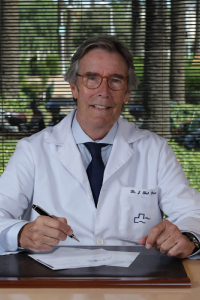

 Centro Médico Teknonen/health-centers/centro-medico-teknon
Centro Médico Teknonen/health-centers/centro-medico-teknon Centro Médico Teknonen/health-centers/centro-medico-teknonHospital Quirónsalud Barcelonaen/health-centers/hospital-quironsalud-barcelona
Centro Médico Teknonen/health-centers/centro-medico-teknonHospital Quirónsalud Barcelonaen/health-centers/hospital-quironsalud-barcelona- Centro Médico Teknonen/health-centers/centro-medico-teknonHospital Quirónsalud Barcelonaen/health-centers/hospital-quironsalud-barcelona
What is breast cancer?
The breast consists of a series of mammary glands interconnected by tubes known as mammary ducts, which carry milk to the nipple during lactation. The mammary glands and ducts are embedded in adipose tissue and the conjunctive tissue, which together with the lymphatic tissue make up the breast. Breast cancer is the abnormal and disordered growth of the cells of this tissue.
Most tumours occurring in the breast are benign tumours, which are non-cancerous and are caused by fibrocystic nodules. The fluid they contain can be drained off and any pain relieved. Benign tumours are largely related to genetic factors. Their symptoms are pain and inflammation, but they do not spread to other parts of the body and are not dangerous.
There are however malign tumours, which are either localized or have spread through the blood or lymphatic vessels, giving rise to metastasis, a cancer in an organ different from that where they originated. Of all the cases of breast cancer, only from 7% to 10% present metastasis at the outset.
15,000 new cases are diagnosed in Spain every year, and one in every 16 or 18 Spanish women are expected to suffer from breast cancer. Breast cancer is the primary cause of death from cancer in women between the ages of 45-55 years, while the the rate of cure in Spain is approximately 60%. Early detection, before the tumour has had the chance to spread, brings the rate of recovery up to almost 90%.
- Tumores benignos
- Tumores malignos
- Tipos de cáncer de mama
- ¿Es una enfermedad frecuente?
- TNM Classification
- Stages
What are risk factors of breast cancer?
- Sex: breast cancer is found mainly in women.
- Age: older women are more likely to develop cancer. 60% of breast tumours occur in women of more than 60 years of age.
- Genes: there exist two identified genes which, when undergoing some type of change (mutation), are associated with a higher likelihood of breast cancer. These genes are known as BRCA1 and BRCA2, and according to some studies it seems likely that 50% to 60% of women who have inherited these mutated genes may develop cancer before the age of 70.
- Family background: if a close relation(mother, sister, daughter) has had breast cancer, the risk of developing a cancer is doubled. This risk increases only slightly if a distant relation (grandmother, aunt, cousin) has had breast cancer.
- Personal background: although moderate, risk appears to increase in those women who have a large number of mammary ducts. For those women who have already suffered cancer in one breast, the chances of developing the disease in a second breast is different from the recurrence or reappearance of the first cancer.
- Race: white Caucasian women are more likely to suffer from this disease than black women. Those with the lowest risk of suffering from cancer are Asian or Hispanic women.
- Menstruation: the earlier that periods begin (before the age of 12) the greater the risk of cancer (from two to four times higher). As regards the menopause, those women who undergo the menopause later in life (after the age of 55) are at greater risk. Pregnancy after the age of 30 also incurs a greater risk of developing the disease. However, these factors frequently have little incidence on the risk of developing cancer.
- Lifestyle: hormone replacement therapy (long-term risk increase in suffering from breast cancer), alcohol, excess weight, etc.
- Symptoms of breast cancer
What are the symptoms of breast cancer?
In its early stages, breast cancer in women does not often present symptoms. The first sign is frequently the appearance of a lump,which when touched feels different from normal mammary tissue. It is often hard, has irregular edges and is painless. Changes in skin colour and tautness around the affected area may sometimes be noticed. In its early stages, the lump may feel loose and can be moved with the fingers. Subsequently, the tumour adheres to the chest wall or the skin and becomes fixed.
Other symptoms may be painful nipples, rashes, cracking or reddening of the skin, and secretions from the nipple that are not maternal milk.
- Regular self-examination
- Diagnosis at the clinic: Various techniques exist for the diagnosis of breast cancer:
- Mammograph
- Ecograph
- Magnetic Resonance Imaging (MRI)
- Tomograph
- Biopsy
- Other tests
What is the treatment of breast cancer?
Treatment will be determined by the size of the tumour and its extension to ganglia or other parts of the body. Generally speaking, when a tumour is less than 1cm, surgery is sufficient for removing the cancer, without chemotherapy, although this is not the most frequent case. At present, the most important factor for prognosis is still axillary lymph nodes gangliar affectation: the number of affected ganglia help the gynecologist to decide on subsequent treatment.
- Follow-up
After treatment for the removal of breast cancer, the patient is subject to strict monitoring over a 5-year period. At the end of this time, she must have the same regular check-ups as any healthy patient.
For the first two years, the patient should be physically examined every three months and have a mammogram every year.
For the remaining three years, physical examinations should be carried out every six months, together with the annual mammograph.



































